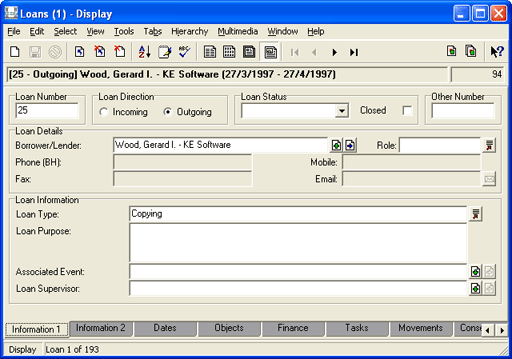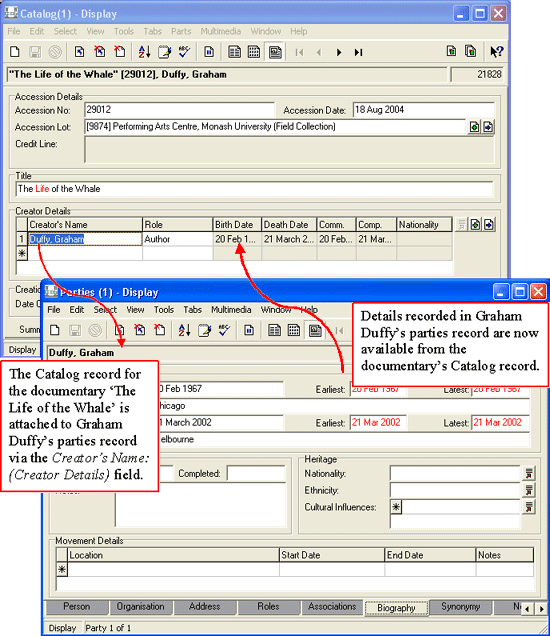In EMu the information about your collection is stored in various modules, each specific to the type of information recorded. For example, the Catalog module records details about the items in your collection; the Parties module stores information about people and organi
Where records in different modules relate to each other, they are linked together through a simple process called Attachment (definitions of the Attachment terminology are available below). For example:
- An item recorded in the Catalog module would attach to:
- One or more records in the Parties module which specify the item collection manager and/or curator.
- A record in the Accession Lots module which specifies the acquisition source and method for the item.
- An Internal Movements record would attach to a record in the Locations module which specifies the details of a given location.
- A Loans record would attach to a record in the Catalog module for the object on loan and to a record in the Parties module which specifies the party to whom the object is on loan.
An attachment field is a field in a module that can be linked to a related record in another module. It can be identified by the Attachment  and View Attachment
and View Attachment  buttons beside it, e.g. the
buttons beside it, e.g. the

Note:
The View Attachment  button is gr
button is gr
As we see in How to make, view and delete attachments there are several methods you can use to attach records.
Graham Duffy's documentary, The Life of the Whale, is received by your institution. To record this information in EMu you would create two records:
- A record for the documentary itself in the Catalog module.
- A record for Graham Duffy in the Parties module.
You would then Attach (link) the two records to each other.
So, the three steps are:
- Create a record in the Catalog module recording details about the documentary, e.g. title, discipline, object type, etc.
- Create a record in the Parties module recording details about Graham Duffy, e.g. name, address, email address, date of birth, etc.
- In the Catalog module there is a group of fields called Creator Details and it is here that the Graham Duffy record in the Parties module is attachedto the documentary record in the Catalog module:

Even though the information is stored in two modules, you could now search for information about Graham Duffy and would find out which documentary he created, or you could search for the documentary and would also find information about Graham Duffy.
Let's say your institution now receives a copy of Graham Duffy's second documentary, The Mating Customs of the Whale. To record this in EMu you would:
- Create a new Catalog record for The Mating Customs of the Whale.
- Attach Graham Duffy's existing Parties record to the Catalog record for The Mating Customs of the Whale.
Thus, one advantage of the Attachment process is that
Information stored in one record can be attached to many other records.
For example, a single insurance policy can provide cover for many items in the Catalog. The insurance policy is entered into the Insurance module once and then attached to every item in the Catalog module covered by the policy. If the insurance policy details change, only the insurance record needs to be updated. The Catalog records automatically display the correct information.
It is possible to search for records using search data in an attached module. For instance you could search the Catalog module for items created by Graham Duffy.
See How do I search an attachment field? for details.
|
Term |
Definition |
|---|---|
|
Attachment |
A link between a record in a module and a record in the same or another module.
|
|
Primary and Target module / record |
In this example the Most modules can be both Primary and Target modules (simultaneously). For instance, the |
|
The term Reverse Attachment simply means tracing an attachment back from the Target to the Primary record. From a Primary record it is a simple matter to navigate to a record that it has linked to. It is also possible to navigate from the Target record back to the record that linked to it.
|
